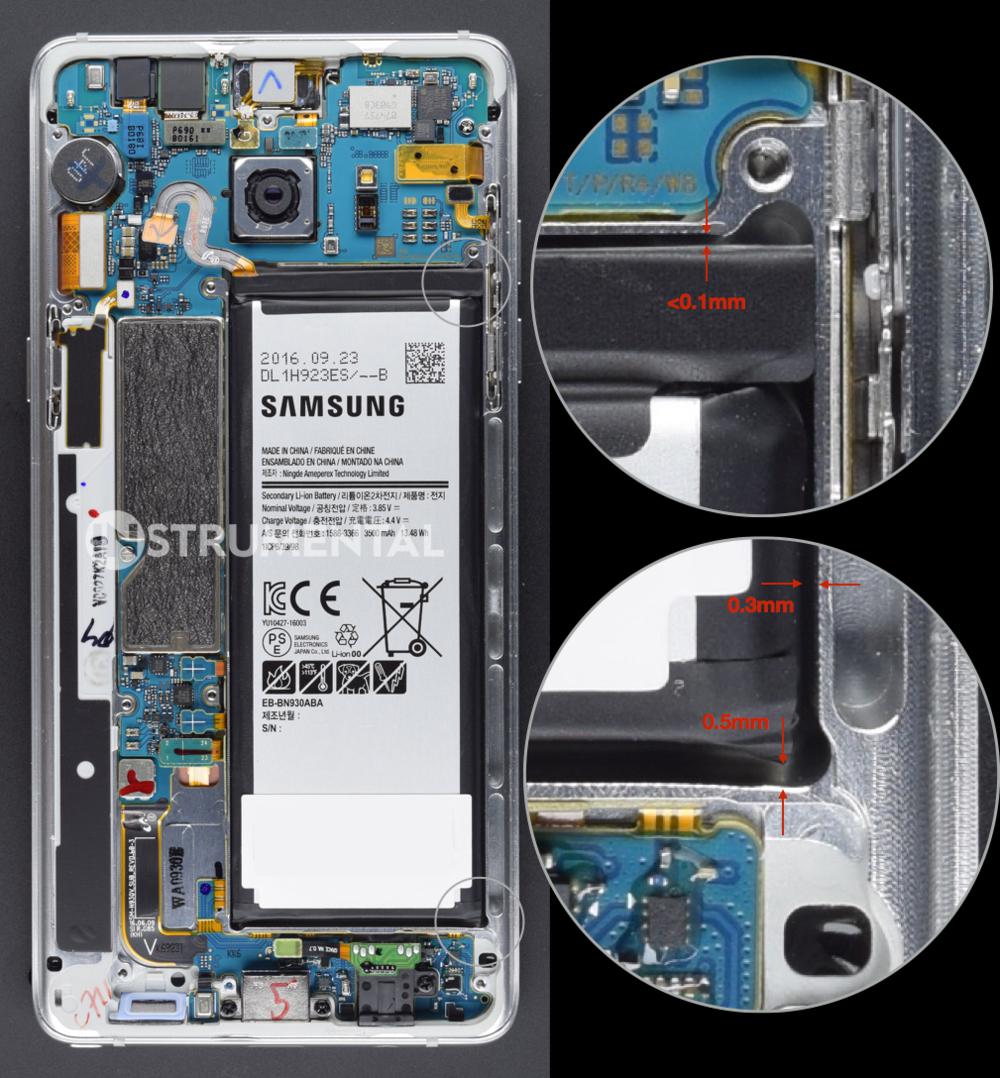While Samsung is trying to forget what happened with the Note 7 and tries to move on wards, there never has been given a valid reason as to why the batteries in the Note 7 became so unstable. A number of hardware engineers analyzed and came to a conclusion.
Two engineers dissected the Note 7 and came to some conclusions, from the ground up the Note 7 battry exceeded limits that Samsung should have never passed. The information comes from instrumental.ai, we'll paste their entire explanation here as posted by by Anna Shedletsky:
In September, the first reports of Samsung Galaxy Note 7 batteries exploding hit social media. At first, Samsung identified the issue as one relating to the lithium polymer battery manufacturing process by Samsung SDI, where too much tension was used in manufacturing, and offered to repair affected phones. But several weeks later, some of the batteries in those replacement units also exploded once they were in the hands of customers -- causing Samsung to make the bold decision to not only recall everything, but to cancel the entire product line.
This is every battery engineer’s nightmare. As hardware engineers ourselves, Sam and I followed the story closely. Different sources at Samsung reported different reasons for why the batteries shorted: tension in the cell fabrication, squeezing the layers too much during processing, poorly positioned insulation tape, etc. These theories all suggest a battery part-level issue, likely due to Samsung pushing the manufacturing parameters a little too far in order to make the highest capacity battery in the smallest package. But, if it was only a battery part issue and could have been salvaged by a re-spin of the battery, why cancel the product line and cede several quarters of revenue to competitors? We believe that there was more in play: that there was a fundamental problem with the design of the phone itself.
Teardown
We acquired a Galaxy Note 7 and with a fire extinguisher close at hand, tore it down. We used an Instrumental station to document the process. What we found was surprising: the design can compress the battery even during normal operation (see footnote).
Why does this matter? The Note 7’s lithium-polymer battery is a flattened “jelly-roll” consisting of a positive layer made of lithium cobalt oxide, a negative layer made of graphite, and two electrolyte-soaked separator layers made of polymer. The separator layers allow ions (and energy) to flow between the positive and negative layers, without allowing those layers to touch. If the positive and negative layers ever do touch, the energy flowing goes directly into the electrolyte, heating it, which causes more energy to flow and more heat -- it typically results in an explosion. Compressing the battery puts pressure on those critical polymer separator layers that keep the battery safe. Samsung stated that these separator layers may have been thin to start with due to aggressive manufacturing parameters. Add some pressure due to normal mechanical swell from the battery or accumulated stress through the back cover (e.g. from being sat on in a back pocket), and that pressure could be enough to squeeze the thin polymer separator to a point where the positive and negative layers can touch, causing the battery to explode.
What’s interesting is that there is evidence in the design of an intellectual tension between safety and pushing the boundaries. Samsung engineers designed out all of the margin in the thickness of the battery, which is the direction where you get the most capacity gain for each unit of volume. But, the battery also sits within a CNC-machined pocket -- a costly choice likely made to protect it from being poked by other internal components. Looking at the design, Samsung engineers were clearly trying to balance the risk of a super-aggressive manufacturing process to maximize capacity, while attempting to protect it internally.
Pushing the boundaries
While we were doing the teardown, Sam wondered, “Samsung engineers are smart. Why would they design it like this?” The answer isn’t a mystery: innovation means pushing the boundaries. For something that is innovative and new, you design the best tests that you can think of, and validate that the design is okay through that testing. Battery testing takes a notoriously long time (as long as a year for certain tests), and thousands of batteries need to be tested to get significant results. It’s possible that Samsung’s innovative battery manufacturing process was changing throughout development, and that the newest versions of the batteries weren’t tested with the same rigor as the first samples.
If the Galaxy Note 7 wasn’t recalled for exploding batteries, Sam and I believe that a few years down the road these phones would be slowly pushed apart by mechanical battery swell. A smaller battery using standard manufacturing parameters would have solved the explosion issue and the swell issue. But, a smaller battery would have reduced the system’s battery life below the level of its predecessor, the Note 5, as well as its biggest competitor, the iPhone 7 Plus. Either way, it’s now clear to us that there was no competitive salvageable design.
The design and validation process for a new product is challenging for everyone. In this case, Samsung took a deliberate step towards danger, and their existing test infrastructure and design validation process failed them. They shipped a dangerous product. That this is possible at one of the top consumer electronic companies in the world is humbling -- and demonstrates the need for better tools. Instrumental is building them.
Footnote: When batteries are charged and discharged, chemical processes cause the lithium to migrate and the battery will mechanically swell. Any battery engineer will tell you that it’s necessary to leave some percentage of ceiling above the battery, 10% is a rough rule-of-thumb, and over time the battery will expand into that space. Our two-month old unit had no ceiling: the battery and adhesive was 5.2 mm thick, resting in a 5.2 mm deep pocket. There should have been a 0.5 mm ceiling. This is what mechanical engineers call line-to-line -- and since it breaks such a basic rule, it must have been intentional. It is even possible that our unit was under pressure when we opened it.


